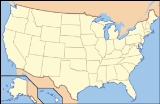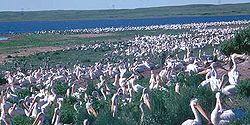
Chase Lake Wetland Management District
Encyclopedia
Chase Lake Wetland Management District is located in the U.S. state
of North Dakota
. The district is located in what is known as the prairie–potholes region of lakes and ponds, which were left behind by the retreat of glaciers at the end of the last ice age
. Hundreds of waterfowl production areas
, Wildlife Development Areas, wetland easements (private land managed by the government), grassland easements and the easement refuge known as Halfway Lake National Wildlife Refuge
, are managed by the district. The district is a part of the Arrowwood National Wildlife Refuge Complex
.
 In the district, hundreds of thousands of birds either migrate through the region or stay and nest every year. Important waterfowl include the American white pelican
In the district, hundreds of thousands of birds either migrate through the region or stay and nest every year. Important waterfowl include the American white pelican
whose numbers in the district are higher than in any other protected region in North America
. Tundra swans, canada geese, bittern
s, wood duck
s, black-crowned night heron
s, pintail
s, franklin's gull
and the great blue heron
are but a sampling of the 250 species of birds that have been identified on the refuge. White-tailed deer
, muskrat
, beaver
, raccoon
and skunk
are but a few of the 40 mammal species that have been documented.
The district permits hunting and fishing within regulations, and proceeds from Duck Stamps sold to duck hunters are used to manage existing protected areas, as well as purchase additional lands from willing private landowners.
U.S. state
A U.S. state is any one of the 50 federated states of the United States of America that share sovereignty with the federal government. Because of this shared sovereignty, an American is a citizen both of the federal entity and of his or her state of domicile. Four states use the official title of...
of North Dakota
North Dakota
North Dakota is a state located in the Midwestern region of the United States of America, along the Canadian border. The state is bordered by Canada to the north, Minnesota to the east, South Dakota to the south and Montana to the west. North Dakota is the 19th-largest state by area in the U.S....
. The district is located in what is known as the prairie–potholes region of lakes and ponds, which were left behind by the retreat of glaciers at the end of the last ice age
Ice age
An ice age or, more precisely, glacial age, is a generic geological period of long-term reduction in the temperature of the Earth's surface and atmosphere, resulting in the presence or expansion of continental ice sheets, polar ice sheets and alpine glaciers...
. Hundreds of waterfowl production areas
Waterfowl production areas
Waterfowl production areas are a small component of the National Wildlife Refuge System. There are over of this prime duck-producing land, mostly prairie potholes in the Dakotas, Minnesota, and Montana. The Fish and Wildlife Service owns, leases, or holds easements on the lands....
, Wildlife Development Areas, wetland easements (private land managed by the government), grassland easements and the easement refuge known as Halfway Lake National Wildlife Refuge
Halfway Lake National Wildlife Refuge
The Halfway Lake National Wildlife Refuge is located in the U.S. state of North Dakota and consists of 160 acres The refuge is a privately owned easement refuge, managed by the U.S. Fish and Wildlife Service. The refuge is closed to the public and was established to protect habitat for...
, are managed by the district. The district is a part of the Arrowwood National Wildlife Refuge Complex
Arrowwood National Wildlife Refuge Complex
The Arrowwood National Wildlife Refuge Complex consists of numerous National Wildlife Refuges and Wetland Management Districts in the U.S. state of North Dakota. Altogether, twelve separate areas are in the complex, with the Chase Lake Prairie Project being the largest at...
.

American White Pelican
The American White Pelican is a large aquatic bird from the order Pelecaniformes. It breeds in interior North America, moving south and to the coasts, as far as Central America, in winter....
whose numbers in the district are higher than in any other protected region in North America
North America
North America is a continent wholly within the Northern Hemisphere and almost wholly within the Western Hemisphere. It is also considered a northern subcontinent of the Americas...
. Tundra swans, canada geese, bittern
Bittern
Bitterns are a classification of birds in the heron family, Ardeidae, a family of wading birds. Species named bitterns tend to be the shorter-necked, often more secretive members of this family...
s, wood duck
Wood Duck
The Wood Duck or Carolina Duck is a species of duck found in North America. It is one of the most colourful of North American waterfowl.-Description:...
s, black-crowned night heron
Black-crowned Night Heron
The Black-crowned Night Heron commonly abbreviated to just Night Heron in Eurasia, is a medium-sized heron found throughout a large part of the world, except in the coldest regions and Australasia .-Description:Adults are...
s, pintail
Northern Pintail
The Pintail or Northern Pintail is a widely occurring duck which breeds in the northern areas of Europe, Asia and North America. It is strongly migratory and winters south of its breeding range to the equator...
s, franklin's gull
Franklin's Gull
The Franklin's Gull is a small gull.-Description:It breeds in central provinces of Canada and adjacent states of the northern United States...
and the great blue heron
Great Blue Heron
The Great Blue Heron is a large wading bird in the heron family Ardeidae, common near the shores of open water and in wetlands over most of North and Central America as well as the West Indies and the Galápagos Islands. It is a rare vagrant to Europe, with records from Spain, the Azores and England...
are but a sampling of the 250 species of birds that have been identified on the refuge. White-tailed deer
White-tailed Deer
The white-tailed deer , also known as the Virginia deer or simply as the whitetail, is a medium-sized deer native to the United States , Canada, Mexico, Central America, and South America as far south as Peru...
, muskrat
Muskrat
The muskrat , the only species in genus Ondatra, is a medium-sized semi-aquatic rodent native to North America, and introduced in parts of Europe, Asia, and South America. The muskrat is found in wetlands and is a very successful animal over a wide range of climates and habitats...
, beaver
Beaver
The beaver is a primarily nocturnal, large, semi-aquatic rodent. Castor includes two extant species, North American Beaver and Eurasian Beaver . Beavers are known for building dams, canals, and lodges . They are the second-largest rodent in the world...
, raccoon
Raccoon
Procyon is a genus of nocturnal mammals, comprising three species commonly known as raccoons, in the family Procyonidae. The most familiar species, the common raccoon , is often known simply as "the" raccoon, as the two other raccoon species in the genus are native only to the tropics and are...
and skunk
Skunk
Skunks are mammals best known for their ability to secrete a liquid with a strong, foul odor. General appearance varies from species to species, from black-and-white to brown or cream colored. Skunks belong to the family Mephitidae and to the order Carnivora...
are but a few of the 40 mammal species that have been documented.
The district permits hunting and fishing within regulations, and proceeds from Duck Stamps sold to duck hunters are used to manage existing protected areas, as well as purchase additional lands from willing private landowners.

